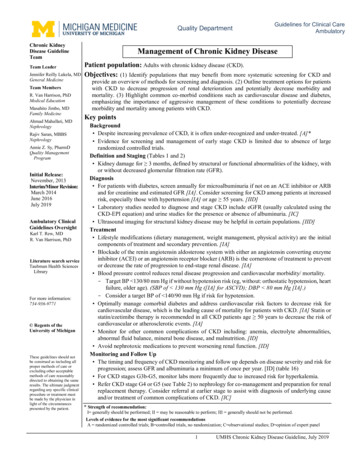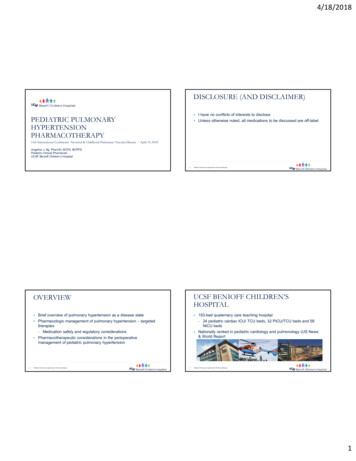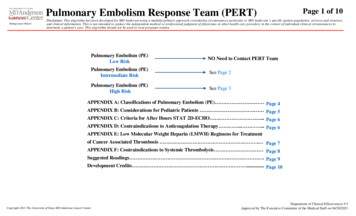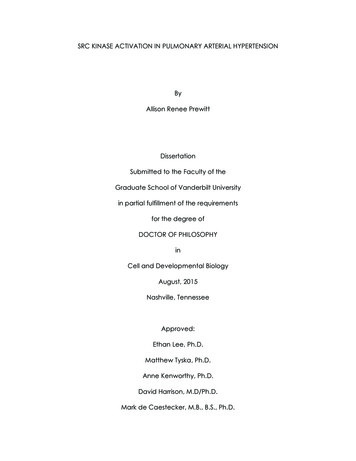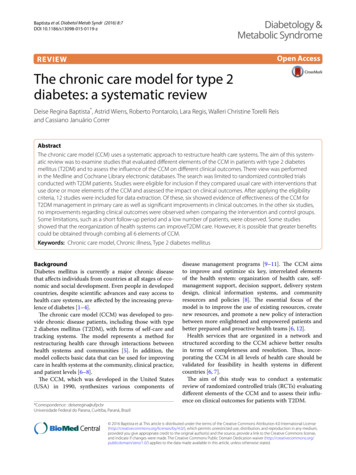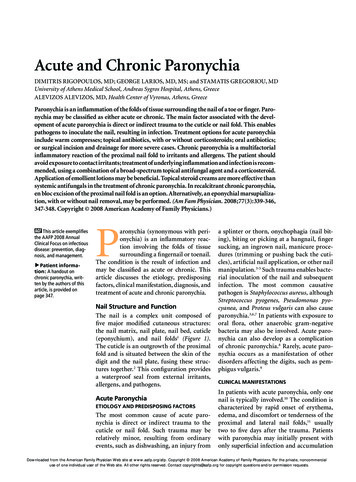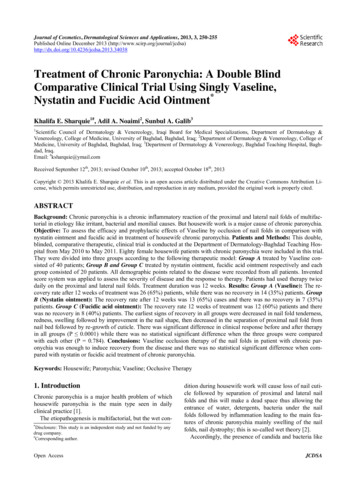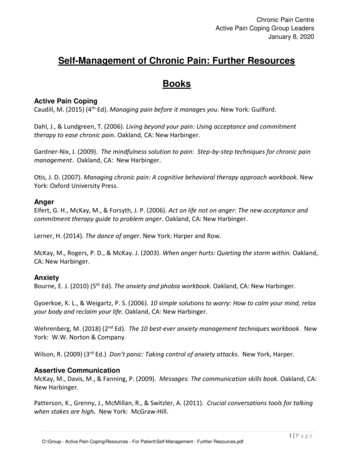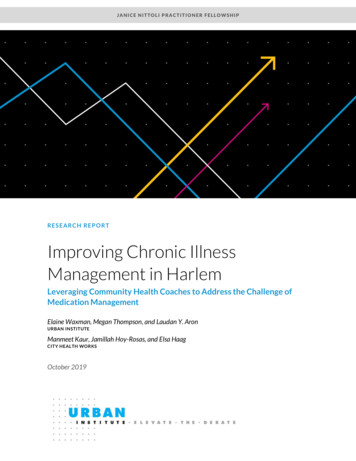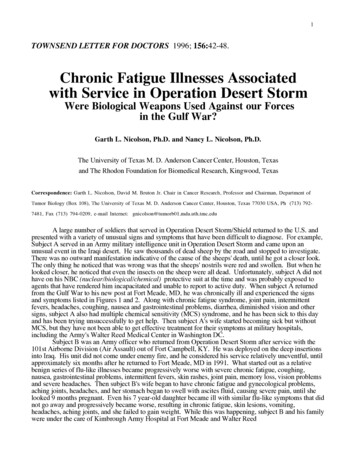
Transcription
224Population Genomics and Alpha-1 Antitrypsin DeficiencyChronic Obstructive Pulmonary Diseases:Journal of the COPD FoundationReviewLeveraging Population Genomics for Individualized Correction ofthe Hallmarks of Alpha-1 Antitrypsin DeficiencyChao Wang, PhD1* Pei Zhao, PhD1* Shuhong Sun, PhD1* Jeffrey Teckman, MD2 William E. Balch, PhD1AbstractDeep medicine is rapidly moving towards a high-definition approach for therapeutic management of the patientas an individual given the rapid progress of genome sequencing technologies and machine learning algorithms.While considered a monogenic disease, alpha-1 antitrypsin (AAT) deficiency (AATD) patients present withcomplex and variable phenotypes we refer to as the “hallmarks of AATD” that involve distinct molecularmechanisms in the liver, plasma and lung tissues, likely due to both coding and non-coding variation as well asgenetic and environmental modifiers in different individuals. Herein, we briefly review the current therapeuticstrategies for the management of AATD. To embrace genetic diversity in the management of AATD, we providean overview of the disease phenotypes of AATD patients harboring different AAT variants. Linking genotypicdiversity to phenotypic diversity illustrates the potential for sequence-specific regions of AAT protein folddesign to play very different roles during nascent synthesis in the liver and/or function in post-liver plasmaand lung environments. We illustrate how to manage diversity with recently developed machine learning (ML)approaches that bridge sequence-to-function-to-structure knowledge gaps based on the principle of spatialcovariance (SCV). SCV relationships provide a deep understanding of the genotype to phenotype transformationinitiated by AAT variation in the population to address the role of genetic and environmental modifiers in theindividual. Embracing the complexity of AATD in the population is critical for risk management and therapeuticintervention to generate a high definition medicine approach for the patient.Abbreviations: alpha-1 antitrypsin, AAT; alpha-1 antitrypsin deficiency, AATD; machine learning, ML; spatial covariance, SCV; cysticfibrosis, CF; Neimann-Pick C1, NCP1; chronic obstructive pulmonary disease, COPD; endoplasmic reticulum, ER; neutrophil elastase,NE; genome-wide association study, GWAS; carbamazepine, CBZ; trimethylamine N-oxide, TAMO; 4-phenylbutric acid, PBA; histonedeacetylase inhibitor, HDACi; suberoylanilide hydroxamic acid, SAHA; wild-type, WT; adenovirus, AVV; retrovirus, RTV; adeno-associatedvirus, AAV; small interfering RNA, siRNA; human Z-AAT, hZ-ATT; human-induced pluripotent stems cells, hIPSCs; human mesenchymalstem cells, hMSCs; allele frequency, AF; variation spatial profiling, VSP; Gaussian process regression, GPR; cystic fibrosis transmembraneconductance regulator, CFTRFunding Support: WEB is supported by a grant from the National Institutes of Heath (HL141810). JT is supported by the Alpha-1Foundation. The meeting leading to this perspective was generously sponsored by the Alpha-1 Foundation.Date of Acceptance: January 28, 2020Citation: Wang C, Zhao P, Shuhong S, Teckman J, Balch WE. Leveraging population genomics for individualized correction of the hallmarksof alpha-1 antitrypsin deficiency. Chronic Obstr Pulm Dis. 2020;7(3):224-246. doi: https://doi.org/10.15326/jcopdf.7.3.2019.01671 Department of Molecular Medicine, Scripps Research, La Jolla,California2 Pediatrics and Biochemistry, Saint Louis University, and CardinalGlennon Children’s Medical Center, St. Louis, Missouri* These authors contributed equally as joint first authorsKeywords:Address correspondence to:William E. Balch, PhDDepartment of Molecular MedicineScripps ResearchLa Jolla, CaliforniaEmail: webalch@scripps.edualpha-1 antitrypsin deficiency; genotypes; phenotypes; deepmedicine; spatial covarianceFor personal use only. Permission required for all other uses.journal.copdfoundation.org JCOPDF 2020Volume 7 Number 3 2020
225Population Genomics and Alpha-1 Antitrypsin DeficiencyIntroductionRecent advances in genome sequencing technologyis transforming our understanding and applicationof genomics to monogenic rare disease, for example,developing molecular therapeutics that target specificgenetic variants in cystic fibrosis (CF) and NiemannPick C1 (NPC1),1-5 as well as to complex polygenicdiseases6,7 such as risk assessment for chronicobstructive pulmonary disease (COPD).8 In addition togenomics, the development of techniques to monitorother personal omics, for example, epigenomics,5,9,10proteomics,11,12 metabolomics,13 microbiomics,14environmental exposomics15 and human activitytracking,16 as well as rapid progress of machinelearning (ML) analytical tools,1,17,18 is alreadyadvancing deep medicine19 at a high-definition20 andhigh-performance level.21 Here, the patient is viewedas an individual in a population rather than beingtreated as an average of the population as occurs inconventional medicine.Alpha-1 antitrypsin deficiency (AATD) is amonogenic familiar disease that is driven by basic andclinical hallmarks (Figure 1), each of which is uniquelyinfluenced by genetic diversity in the population. Eachof these hallmarks illustrate the complexity of diseaseassociated with each patient in terms of genetics,tissue pathology (liver, plasma, lung), time of onset,progression and the environment. AATD is caused bygenetic variants (alleles) in the SERPINA1 gene whichhas been identified in all ethnic groups worldwide witha frequency of 1 in every 2500 whites of Europeandescent.22 Thought of as a monogenetic disease, AATDpatients present highly variable phenotypes at differenttime frames with unique mechanisms that involve bothgain and loss of function in different tissues (Figure1). Alpha-1 antitrypsin (AAT) is synthesized in theendoplasmic reticulum (ER) and secreted from theliver through the exocytic pathway in large quantitieson a daily basis to maintain a plasma concentration at1-2 g/L.23,24 A well-established biological functionof AAT is its antiprotease activity within the lung thatprevents tissue degradation by neutrophil elastase(NE) and is currently the most established genomewide association study (GWAS) modifier leading toCOPD.25 More recently, AAT has been shown to haveanti-inflammatory and immunomodulatory functionsindependent of the antiprotease activity that maycontribute to AATD phenotypes.26-29Approximately 95% of severe AATD cases arecaused by the Z allele22,30 where the glutamic acidresidue is mutated to lysine residue at position 366 inthe AAT polypeptide (sequence numbering includingthe signal polypeptide sequence). The Z variant leadsto misfolding and polymerization of AAT in the ERof hepatocytes which can trigger hallmarks of liverdisease phenotypes including chronic hepatitis,cirrhosis and hepatocellular carcinoma31 (Figure 1).Liver disease phenotypes are very heterogeneous inpresentation with only about 10%-15% of infants withhomozygous Z variant (PiZZ) developing clinicallyrelevant liver disease,32-34 although all homozygoteshave some degree of accumulation of misfolded Zprotein in the liver35 upon aging and progression of thedisease (Figure 1). Epigenetic mechanisms includingDNA methylation10 as well as polymorphisms inER mannosidase 1 gene (MAN1B1)36 impactingglycosylation patterns, contribute to AATD liverphenotypes in subgroup cohorts37 (Figure 1). Thereis also evidence that inherited traits influencingintracellular proteolysis mechanisms play a role inliver disease susceptibility. Due to the accumulationand degradation of Z-AAT in the ER of hepatocytes, akey hallmark of the disease is that only 10% to 15% ofZ-AAT is secreted into the circulation (Figure 1). Theloss of AAT function disrupts protease-antiproteasebalance in the serum and lung, triggering emphysemaand COPD34 (Figure 1). Environmental factors,including cigarette smoke38 and air pollution39,40contribute to the lung disease phenotype (Figure 1).Moreover, genetic modifiers including, for example,variants in matrix metalloproteinase 1 (MMP1),41tumor necrosis factor,42 interleukin 10 (IL10),43 ironregulatory binding protein 2 (IREB2) and cholinergicnicotine receptor alpha3 (CHRNA3)44 impact thelung disease phenotypes in AATD (Figure 1). Theheterogeneity and complexity of AATD presentationin the clinic indicates the importance of developinga high-definition, deep medicine20 approach for eachindividual patient based on their genome sequence(Figure 1).Herein, we briefly review the current therapeuticapproaches for AATD. Not surprisingly, all effortsto date nearly exclusively focus on restoration offunction of the dominant Z-variant polymerization.Thus, current approaches illustrate potential avenuesfor intervention for a single variant but fall short ofthe real problem– diversity in the population whichFor personal use only. Permission required for all other uses.journal.copdfoundation.org JCOPDF 2020Volume 7 Number 3 2020
226Population Genomics and Alpha-1 Antitrypsin DeficiencyFor personal use only. Permission required for all other uses.journal.copdfoundation.org JCOPDF 2020Volume 7 Number 3 2020
227Population Genomics and Alpha-1 Antitrypsin Deficiencymakes it patient-unique. To address this problem, wehighlight genotypic diversity of AAT variants andthe impact of variation on the hallmarks of AATD(Figure 1) driving clinical presentation. Finally, wediscuss the importance of understanding the genotypeto phenotype transformation from the perspectiveof a new paradigm based on the concept of spatialcovariance (SCV) in biology to individualize treatmentof each patient from a genotype first perspective.In essence, we embrace the concept of “leave nopatient behind,” a current goal of the Cystic FibrosisFoundation,2 as the operational paradigm for AATDtreatment.Current Generic TherapeuticApproaches for Z-Variant Alpha-1Antitrypsin DeficiencyThe vast majority of AATD therapeutic efforts targetthe dominant Z-variant allele. Here, the patient istreated as an average of the disease etiology of theZ-variant population based on either a reduced levelof AAT in plasma and/or progression to endpointliver/lung damage.Enzyme ReplacementThe current standard of care is based on the principleof enzyme replacement. Here, a quantitative increasein the serum pool of full-length AAT is mediated byintravenous infusion of plasma derived AAT (60mg/kg/wk), elevating transiently serum AAT to 50%of normal.45 Treatment with 120 mg/kg/wk in arecent clinical trial has been shown to approximatea low-normal serum level of AAT with an associatedincreased antiprotease activity, decreased elastindegradation, and reduced airway inflammation.46 Aproblem with this approach is that it fails to preventthe inherent accumulation and toxic effects of theexpressed Z-variant in the patient.Chemical and Biochemical ApproachesA number of small-molecule chemical andbiochemical approaches are under development forAATD therapy with the goal of fixing the proteinmisfolding problem in the ER. These efforts largelyfocus on the aberrant polymerization events thatleads to liver pathology and markedly reduces proteinsecretion into the plasma leading to reduced functionin the lung.One small-molecule chemical approach thataddresses Z-variant aggregation in the liver makesuse of the Food and Drug Administration (FDA)approved drug carbamazepine (CBZ) that enhancesautophagic pathways thereby reducing Z-AATpolymer intracellular accumulation in multiple celland mouse models of the disease.47 CBZ is currentlyin phase 2 clinical trials for individuals with severeliver disease (NCT01379469).30 Furthermore, thebile compound nor-ursodeoxycholic acid has beenshown to clear 70% of intrahepatic Z-AAT andreduced hepatocellular death through autophagymechanism, suggesting a novel therapeutic approachfor the treatment of liver disease in AATD.48,49An alternative approach to reduce aggregationinvolves the FDA-approved drug rapamycin, anmTOR inhibitor, that has been demonstrated to reducethe accumulation of hepatic polymerized Z-AAT andhepatocellular injury in a Z-AAT transgenic micemodel.50 Moreover, the generic proteostasis51-53drug trimethylamine N-oxide (TAMO) has beenshown to protect Z-AAT protein from heat-inducedpolymerization in vitro, although it has no effecton Z-AAT protein secretion or protein re-foldingin cell models.54 In contrast, beside inhibitingZ-AAT polymerization and enhancing polymerizedZ-AAT degradation, 4-phenylbutyric acid (PBA),as a proteostasis effector of unknown function, hasbeen shown to promote Z-AAT protein secretion andfunction in both cell model and mouse models.55However, in 2 small human phase 2 trials in AATDpatients, PBA had either no significant change onserum AAT levels, or led to a small increased serumAAT level in 11 PiZZ AATD patients.45While the above compounds are thought to directlyimpact proteostasis pathways, histone deacetylaseinhibitors (HDACi), including suberoylanilidehydroxamic acid (SAHA), have been shown toincrease Z-AAT protein secretion from epithelialcell lines to 50% of wild-type (WT) levels.56 Theexact mechanism remains unknown but could reflectepigenetic mechanisms (histone acetylation) leadingto changes in the gene expression profile impactingprotein folding programs and AAT stability in theER, or post-translational mechanisms reflectingacetylation/deacetylation of AAT or membranetrafficking pathways facilitating AAT delivery in thecell.56An alternative chemical strategy is to preventFor personal use only. Permission required for all other uses.journal.copdfoundation.org JCOPDF 2020Volume 7 Number 3 2020
228Population Genomics and Alpha-1 Antitrypsin DeficiencyAAT polymerization using small molecules57,58and peptides.59,60 AAT polymerization blockingmolecules have been developed through virtualligand screening against the hydrophobic cavitywhich is formed by s2A β-sheet, helix D and helixE in the AAT structure.57,58 A number of reagentsha
ournalcopdfoundationorg COPD 2020 Volume 7 umber 3 2020 or personal use only Permission reuired for all other uses makes it patient-unique. To address this problem, we highlight genotypic diversity of AAT variants and the impact of variation on the hallmarks of AATD (Figure 1)
